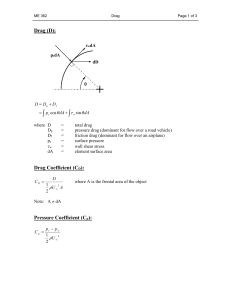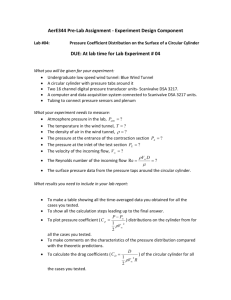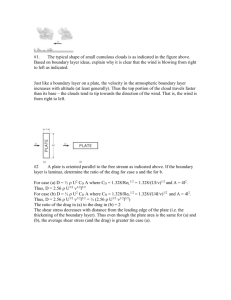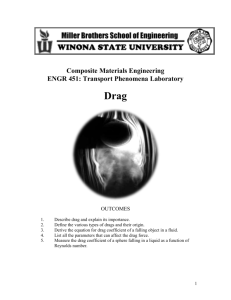Wind tunnel (Experiment 2) ( ) (
advertisement
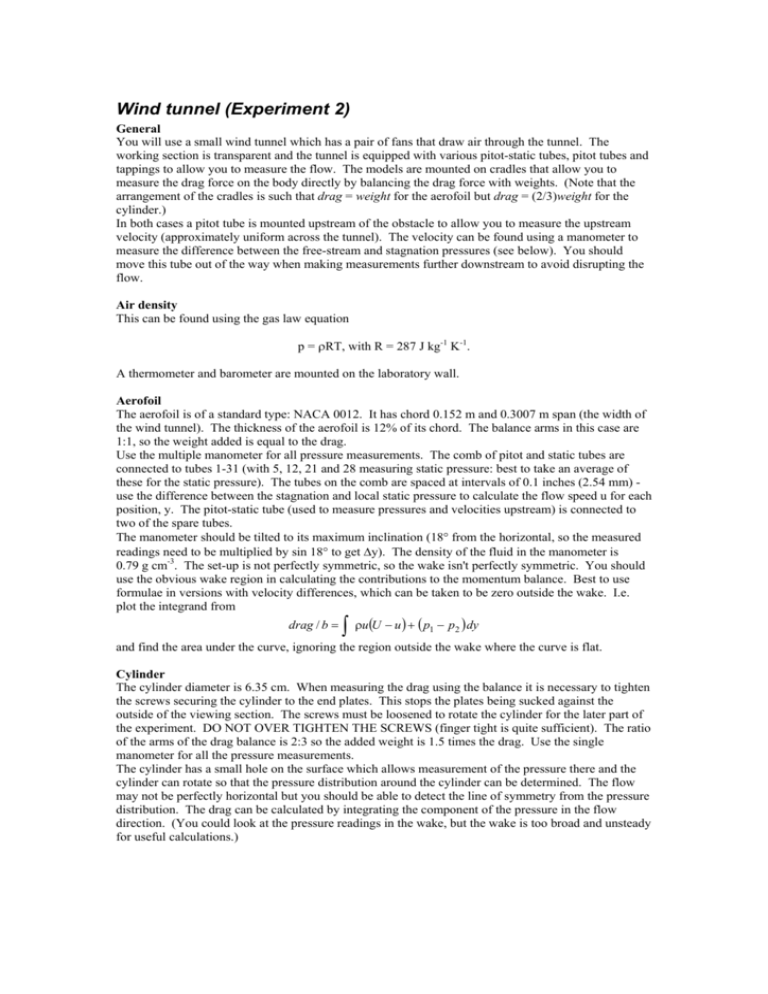
Wind tunnel (Experiment 2) General You will use a small wind tunnel which has a pair of fans that draw air through the tunnel. The working section is transparent and the tunnel is equipped with various pitot-static tubes, pitot tubes and tappings to allow you to measure the flow. The models are mounted on cradles that allow you to measure the drag force on the body directly by balancing the drag force with weights. (Note that the arrangement of the cradles is such that drag = weight for the aerofoil but drag = (2/3)weight for the cylinder.) In both cases a pitot tube is mounted upstream of the obstacle to allow you to measure the upstream velocity (approximately uniform across the tunnel). The velocity can be found using a manometer to measure the difference between the free-stream and stagnation pressures (see below). You should move this tube out of the way when making measurements further downstream to avoid disrupting the flow. Air density This can be found using the gas law equation p = ρRT, with R = 287 J kg-1 K-1. A thermometer and barometer are mounted on the laboratory wall. Aerofoil The aerofoil is of a standard type: NACA 0012. It has chord 0.152 m and 0.3007 m span (the width of the wind tunnel). The thickness of the aerofoil is 12% of its chord. The balance arms in this case are 1:1, so the weight added is equal to the drag. Use the multiple manometer for all pressure measurements. The comb of pitot and static tubes are connected to tubes 1-31 (with 5, 12, 21 and 28 measuring static pressure: best to take an average of these for the static pressure). The tubes on the comb are spaced at intervals of 0.1 inches (2.54 mm) use the difference between the stagnation and local static pressure to calculate the flow speed u for each position, y. The pitot-static tube (used to measure pressures and velocities upstream) is connected to two of the spare tubes. The manometer should be tilted to its maximum inclination (18° from the horizontal, so the measured readings need to be multiplied by sin 18° to get ∆y). The density of the fluid in the manometer is 0.79 g cm-3. The set-up is not perfectly symmetric, so the wake isn't perfectly symmetric. You should use the obvious wake region in calculating the contributions to the momentum balance. Best to use formulae in versions with velocity differences, which can be taken to be zero outside the wake. I.e. plot the integrand from drag / b = ∫ ρu(U − u ) + ( p 1 − p2 ) dy and find the area under the curve, ignoring the region outside the wake where the curve is flat. Cylinder The cylinder diameter is 6.35 cm. When measuring the drag using the balance it is necessary to tighten the screws securing the cylinder to the end plates. This stops the plates being sucked against the outside of the viewing section. The screws must be loosened to rotate the cylinder for the later part of the experiment. DO NOT OVER TIGHTEN THE SCREWS (finger tight is quite sufficient). The ratio of the arms of the drag balance is 2:3 so the added weight is 1.5 times the drag. Use the single manometer for all the pressure measurements. The cylinder has a small hole on the surface which allows measurement of the pressure there and the cylinder can rotate so that the pressure distribution around the cylinder can be determined. The flow may not be perfectly horizontal but you should be able to detect the line of symmetry from the pressure distribution. The drag can be calculated by integrating the component of the pressure in the flow direction. (You could look at the pressure readings in the wake, but the wake is too broad and unsteady for useful calculations.) Report You should prepare a single report covering both the aerofoil and cylinder experiments. The measured and calculated drag can be compared, and you can compare the drag coefficients for the two shapes. The drag on the aerofoil can be compared with the expected drag on (a pair of) flat plates. Flow past bluff and streamlined bodies Drag on an aerofoil In experiment 2 you will be using the control volume technique to calculate the drag on an aerofoil. In the wake of the aerofoil the flow speed is slower, so calculating the momentum flux leaving the control volume requires an integral across the downstream face of the control volume using measured velocities. lift drag wake U u(y) chord = c p1 p2 The aerofoil used in the experiments is symmetric and mounted horizontally (zero angle of attack) so the lift is zero. Equating the rate of change of momentum to the applied forces gives (taking the width of the wind tunnel and the aerofoil to be b), ∫ ρu b dy − ∫ ρU 2 2 b dy = ∫ p b dy − ∫ p b dy − drag . 1 2 Using continuity, ∫U dy = ∫ u dy and so the drag per unit width is drag / b = ∫ ρu(U − u ) + ( p 1 − p2 ) dy . The pressure does not change significantly with y, so the pressure difference can be taken as constant. The calculation of this integral from the experimental data is covered below. Drag coefficients The drag coefficient is defined as drag , 1 ρU 2 A 2 where A is an appropriate area. At high Reynolds number, the drag coefficient is approximately constant and depends on the shape of the obstacle. The area used in the definition is usually the crosssectional area normal to the flow direction (for the aerofoil this would be its thickness×b). However, for the aerofoil it is also useful to compare the measured drag to that you would expect to act on a pair of flat plates each of area A = b×c. In terms of the Reynolds number defined by the length of the plate in the flow direction Re = Uc/ν, Cd = Cd = 1.328 Re-1/2 (laminar), Cd = 0.0315 Re-1/7 (turbulent), Retr ~ (0.5 to 3)×106. Drag on a cylinder Again we can measure the drag force. The area used in the drag coefficient in this case is usually the area facing the flow, i.e. 2Rb. for a cylinder of radius R and length b. Note that the flow pattern for viscous flow is the same as that for potential flow, though the (theoretical) potential flow would produce no drag. At high Reynolds Numbers it is the departure of the real flow pattern from potential flow that produces the drag. In pure potential flow the pressure and velocity are related through Bernoulli's equation and a symmetric flow would have the flow speed rise (and pressure fall) and then return to its original value in a symmetric way around the cylinder, leading to no net force. In practice the flow separates and the pressure behind the cylinder (in the wake region) does not increase. It is this asymmetry that accounts for the drag. (In addition in practice there will be viscous drag on the cylinder surface, but this is usually a relatively small component.) Thus the drag on a cylinder is (mostly) from the pressure forces acting on the cylinder surface. p R θ The horizontal component of the pressure force (per unit width) is given by 2π ∫ pR cos θ dθ 0 and p will be measured directly as a function of θ in the experiment. (The vertical component should be zero.) Pitot and Pitot-static tubes A Pitot-static tube is a thin tube with an opening at the tip, facing the flow, and another opening in the side of the tube. The tip of the probe is a stagnation point, so the velocity is zero there. The pressure difference (e.g. measured by a manometer) gives a measurement of the flow. If the manometer shows a height difference of ∆y and the manometer fluid has density ρm, then the difference in head is and so ∆h = ∆y(ρm - ρ)/ρ = ∆y(ρm/ρ - 1), u2 = 2 g ∆h. A simple pitot tube just has an opening in the tip and the pressure there may be compared with either atmospheric pressure, or the pressure at the side of the channel, wind tunnel or pipe through which the flow is passing. If there is little curvature in the flow then there will be little pressure difference between the side of a pitot-static tube and a side-tapping. 1 2 p 2 q + ρ + gz = constant =gH (along streamlines) Bernoulli's equation. Kinetic energy + potential energy = constant (no friction), H = "head" Some manometers are marked in pressure units (taking account of the manometer fluid density), in which case the difference in head is just given by ∆h = ∆p/gρ, and so u2 = 2 ∆p/ρ.



